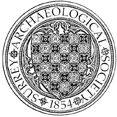Land west of the Town Hall, Epsom
Evaluation by J Robertson of SCAU of land proposed for a new access road to the Town Hall and associated development, for Epsom and Ewell Borough Council. The trial trenching revealed a limited number of archaeological features and finds of probable 18th century and later date, two residual pottery sherds of probable late medieval date, and a number of stray finds of struck and burnt flint. (321)


